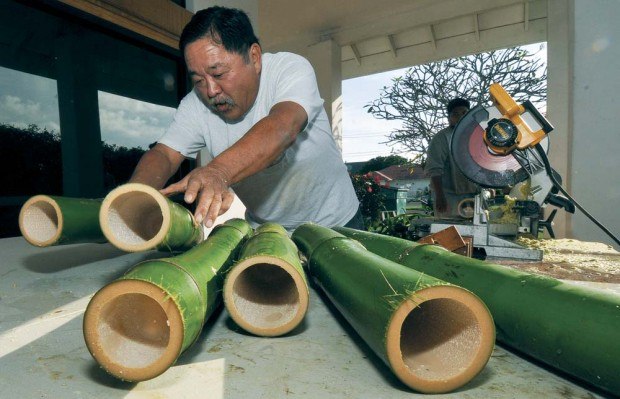LIHU‘E — Kadomatsu arrangements go on sale starting Tuesday at the Hawai‘i Government Employees Association headquarters on Aikahi Street in Lihu‘e, said Gerald Ako, the Kaua‘i director. Ako said HGEA volunteers started working two days ago to begin the process
LIHU‘E — Kadomatsu arrangements go on sale starting Tuesday at the Hawai‘i Government Employees Association headquarters on Aikahi Street in Lihu‘e, said Gerald Ako, the Kaua‘i director.
Ako said HGEA volunteers started working two days ago to begin the process of creating the traditional New Year’s piece.
“We sent teams out to cut the bamboo, Wednesday,” Ako said. “Thursday, there were people collecting the pine in Koke‘e, and we assemble everything Saturday.”
The kadomatsu, or gate pine, arrangement is made of a central bamboo piece garnished with pine sprigs and plum blossoms and is tied together with cord.
According to information from the Japanese Cultural Center of Hawai‘i, the kadomatsu is usually displayed on both sides of an entrance, one representing a female and the other representing the male.
People in Hawai‘i often display and discard the kadomatsu according to customs of their families, usually around the seventh day of January signaling the end of the New Year festivities, the JCCH website states.
In the arrangement, the bamboo represents strength and flexibility while the pine symbolizes constancy, vitality and longevity. The plum blossoms represent new beginnings, purity and sweetness.
Ako said HGEA plans on having about 300 kadomatsu for sale this year, the same amount as previous years.
Funds from the sale of kadomatsu go toward the HGEA scholarship fund and in previous year, the traditional New Year’s arrangement has sold out annually.
Kadomatsu is one of the New Year tradition which started more than 600 years ago in Japan during the Edo period, states the Ornaments to Remember website.
In the 1400s, giant pieces of bamboo were filled with water and sand and placed at doorways in the event of a fire emergency.
Over the years, these giant house guards came to symbolize more than fire prevention and became a favorite way of offering good luck in the New Year.
When the first generation of Japanese immigrants arrived in Hawai‘i, they brought this tradition with them, and today, the kadomatsu is more popular in Hawai‘i than it is in Japan, the website states.
Locally, smaller versions can be found in the produce sections of supermarkets along with a variety of other symbolic New Year foods.
Ako said people can just drop by the HGEA office between 7:30 a.m. to 4:30 p.m. starting Tuesday, or call 245-6751.


